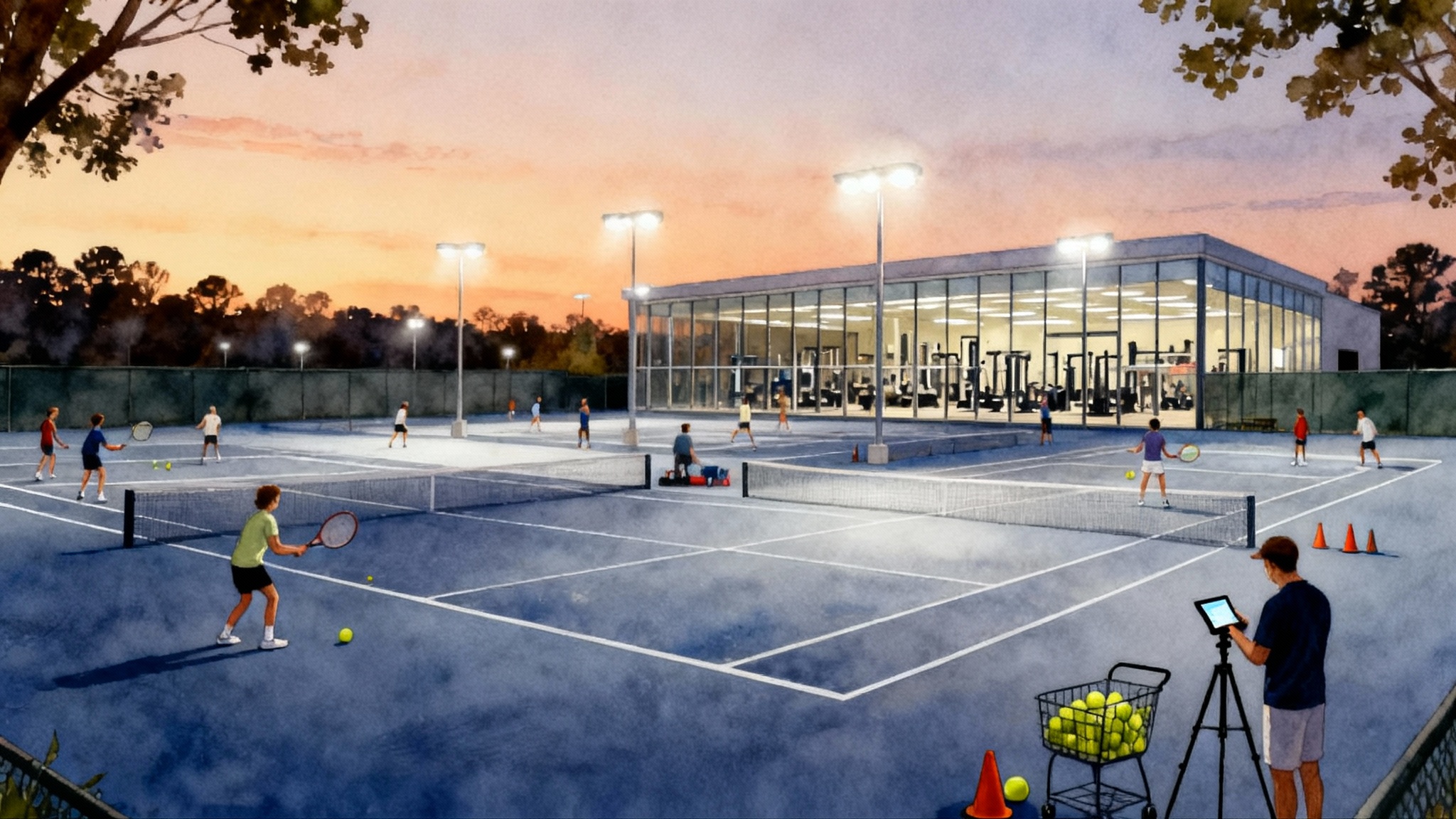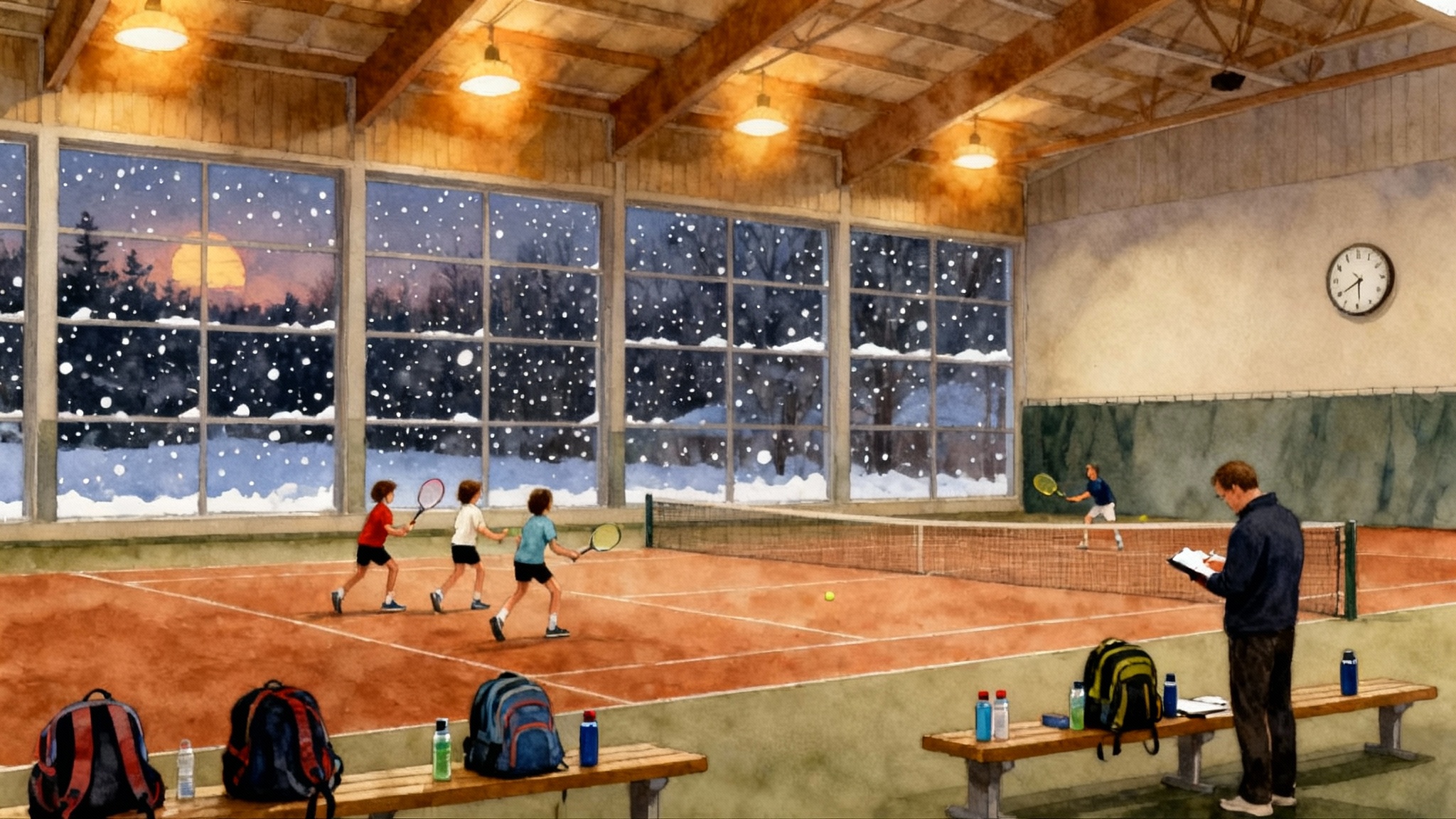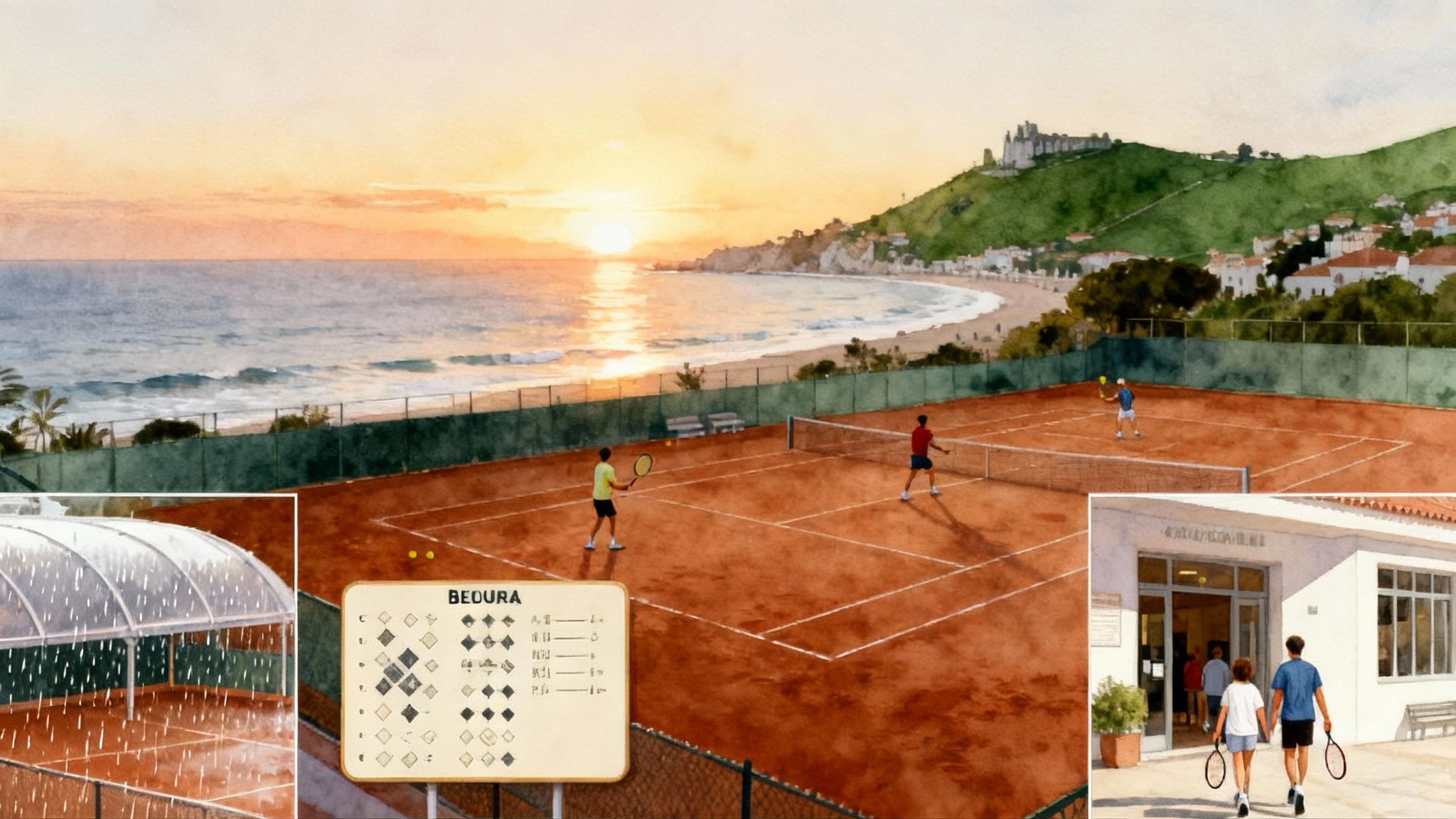Best Atlanta Tennis Academies 2025–2026: Juniors and Adults Guide
A comparison-led guide to Atlanta’s top academies, spotlighting Life Time Tennis Academy in Peachtree Corners alongside club-based and boutique programs. Learn training models, rating pathways, prices, commute fit, and when to enroll.

How to use this guide
Atlanta loves tennis. That is good news if you are choosing an academy for 2025–2026, because the metro area offers a deep mix of club-based programs and boutique academies. The challenge is sorting through styles, schedules, and costs so you can enroll with confidence. This guide compares the most common models in the city, spotlights Life Time Tennis Academy in Peachtree Corners, explains rating and match pathways, and gives you practical timelines and checklists for both families and adult players.
If you want to see how formats differ in other markets, compare our Chicago enrollment guide and Miami–Fort Lauderdale academies guide.
The academy landscape in Atlanta
Most Atlanta academies fit one of three shapes. Knowing which one suits your goals will save you tuition, drive time, and frustration.
-
Club-based academies: These live inside private or semi-private fitness clubs and racquet clubs. Example programs in the metro include Life Time Tennis Academy in Peachtree Corners and large club networks that operate across multiple sites. Strengths include consistent standards, deeper staffing, adult programming on the same campus, and a wide range of court surfaces. Tradeoffs include higher membership costs and busier courts during peak hours.
-
Public-center high performance groups: Several city and county tennis centers host strong junior development and adult clinics. These centers often balance affordability with quality coaching and heavy league play. Expect lively courts, strong local competition, and a clear path into city leagues.
-
Boutique academies: These are smaller, coach-led programs with tight-knit groups and a strong technical or tactical identity. The appeal is personal attention and a defined training voice. The limitation is capacity. Waitlists are common and the weekly schedule may be less flexible.
Spotlight: Life Time Tennis Academy, Peachtree Corners
Life Time Tennis Academy in Peachtree Corners is a flagship example of a modern club-based program. It pairs full-service fitness amenities with a structured pathway for both juniors and adults.
What stands out
- Program breadth: Red ball through college-prep tiers for juniors, and a full range of adult drills, mixers, and league support. Families can place siblings and parents on the same campus without juggling multiple locations.
- Staffing depth: Multiple pros on court allow for true level-based groups, live-ball stations, and video feedback days. That matters when your player moves up a court and still needs the right volume of quality reps.
- Match-play integration: Club academies typically run weekly supervised point play, Universal Tennis Rating events, and in-house ladders. This makes it easier to move from drilling to competing without a long drive on Friday night.
Who it fits
- Busy families in Peachtree Corners, Dunwoody, Johns Creek, Norcross, and Sandy Springs who want one-stop scheduling.
- Players who thrive with a structured curriculum and clear levels.
- Adults who want morning fitness, a lunchtime drill, or an evening league on the same membership.
Questions to ask on your tour
- How many players per court at my level on typical days, not only during evaluations.
- How often do coaches rotate between courts to equalize feedback.
- How does the academy define advancement, and how often are level reviews held.
- What is the plan on rain days. Is there video review, fitness, or rescheduling.
Training models you will see
The best Atlanta programs are moving beyond pure basket feeding. Expect to see three formats blended across the week, each with a purpose.
- Technical blocks: Lower-fed or hand-fed reps to build a stroke change. Film helps here. Ask how often your player gets on camera and how that footage is used in follow-up sessions.
- Live-ball decision training: Cooperative to competitive points with constraints. For example, start with a deep crosscourt to open the court, then play it out. This models true point patterns and rewards intention, not just power.
- Competitive play: Sets, tiebreakers, and situational games that imitate tournament pressure. Look for supervised play where coaches track patterns, not only winners and unforced errors.
A balanced week for a serious junior often includes two technical sessions, two live-ball sessions, and one competitive session. Adults might replace one technical session with a cardio-style workout to build repeatable footwork.
Understanding ratings and match pathways
You will hear two acronyms a lot in Atlanta. Define them early so they serve you rather than confuse you.
- Universal Tennis Rating (UTR): A global rating that moves with every counted match. It is continuous, not divided into rigid categories. Players benefit from frequent verified play against similar ratings because small wins and close losses both move the number. New to UTR? Read about how Universal Tennis works.
- United States Tennis Association (USTA): The national governing body runs junior tournaments that award points by level and also runs adult leagues. In Atlanta, USTA events and city leagues form the backbone of weekend competition. Explore USTA leagues and tournaments.
Practical plan for juniors
- If your player is in 10 and under, emphasize red, orange, and green ball progressions with short-format events. One short event every two to three weeks builds confidence.
- If your player is 11 to 14 and developing, target two Universal Tennis Rating verified match nights per month plus one United States Tennis Association tournament. The first builds repetitions, the second stretches nerves.
- If your player is high school varsity or college hopeful, build cycles of two to three weeks of training followed by a tournament weekend. Between tournaments, schedule one supervised match night per week.
Practical plan for adults
- Choose one anchor league for accountability. In Atlanta, that is often a neighborhood league or a United States Tennis Association team. Add one drill per week that targets a specific pattern, such as return plus first ball.
- Play one singles ladder match per month even if you are doubles focused. The extra baseline time sharpens your return and second serve.
Surfaces, facilities, and weather planning
Atlanta is primarily a hard-court city with pockets of clay. Clay favors longer rallies and is kinder on joints. Hard courts are faster and common at schools and parks.
- If you are returning from an injury, ask for at least one clay session per week for your first month back. The slower surface gives you time to organize your balance and shot shape.
- If you are a serve and forehand player, keep some hard-court reps. You want to rehearse first-strike patterns at true match speed.
- Ask about lighted courts and indoor backups. Storms roll through quickly. Good programs pivot to fitness, classroom scouting, or video analysis when it rains.
Price ranges you can expect in Atlanta
Tuition varies by membership requirements, coach credentials, and group size. Use these ranges to budget. Exact rates change by season and site.
- Junior development, two days per week: usually 250 to 450 dollars per month.
- High performance, three to five days per week: usually 600 to 1,400 dollars per month.
- Private lessons: usually 80 to 140 dollars per hour, more for lead directors.
- Adult clinics: usually 25 to 50 dollars per session, with package discounts.
- Tournament coaching day rates: usually 120 to 250 dollars plus any travel costs.
- Club membership add-ons when required: often 80 to 180 dollars per month for a family tier, plus an initiation fee. Public centers typically charge court fees of a few dollars or use a seasonal pass.
Money-saving ideas
- Ask about daytime pricing if you homeschool or have flexible work hours. Midday courts are cheaper and less crowded.
- Share a semi-private lesson with a same-level partner for targeted work at half the price.
- For adults, rotate one weekly drill with one match-play mixer to keep costs predictable and competitive reps steady.
Commute time and traffic reality
Your perfect program is useless if you cannot reach it at 4:30 p.m. on a school day. Use these real-world ranges as a planning aid. Times are typical on weekdays, not best case.
- Midtown to Peachtree Corners: 35 to 60 minutes in the afternoon.
- Decatur to Piedmont Park area: 20 to 35 minutes depending on events.
- Alpharetta to Sandy Springs: 20 to 40 minutes with variable traffic on Georgia 400.
- East Cobb to Buckhead area courts: 25 to 45 minutes when schools let out.
Strategy: set a maximum car time per practice of 35 minutes for middle-school families and 45 minutes for high-school families. Adults should pick a program that aligns with their commute, not their ideal coach biography. Consistency beats occasional brilliance.
School fit and academic balance
Strong academies protect homework time. Ask for practice blocks that match your school calendar.
- Elementary and middle school: 4:00 to 6:00 p.m. windows reduce late nights.
- High school in season: practices that start after team training end times, often 6:30 p.m. or later, keep burnout away.
- Homeschool and online students: a two-a-day model can work. Use a 90-minute technical session late morning and a live-ball session midafternoon. Protect one full recovery day each week.
During the Georgia high school season, which typically runs in the spring, ask the academy to pause heavy technical changes and focus on patterns that translate immediately to dual matches.
Seasonal enrollment timelines for 2025–2026
Every site sets its own calendar, but most Atlanta programs follow a similar rhythm. Use these date windows to plan. Mark reminders two weeks before each window opens.
- Summer 2025 camps and intensives: registration usually opens in January through March 2025. Many popular weeks fill by early May 2025.
- Fall 2025 term: typical class dates run from early August 2025 to the week before Thanksgiving 2025. Enrollment often opens in late June or July 2025.
- Winter 2025 to 2026 term: typical dates run from late November or early December 2025 through late February 2026. Enrollment often opens in October 2025.
- Spring 2026 term: typical dates run from early March 2026 to late May 2026. Enrollment often opens in January 2026.
If you miss a window, ask about midterm entry. Many academies can place you after a short evaluation and pro-rate tuition.
How top Atlanta programs compare at a glance
Below are common strengths you will see across the metro. Use these traits to match your goals.
- Life Time Tennis Academy, Peachtree Corners: full-service club setting, structured junior pathway, wide adult menu, frequent supervised play, and deep staffing for level-based courts.
- Club-network programs across multiple sites: consistent curriculum, easy make-ups across locations, and strong league support for adults.
- Public-center performance groups: budget friendly, close to neighborhood schools, strong local competition, and a clear bridge into city and United States Tennis Association leagues.
- Boutique academies: tight coach-to-player relationship, detailed technical identity, and smaller groups that move fast. Expect waitlists and a set number of weekly days.
A week that works: sample schedules
For a tournament-focused eighth grader
- Monday: technical session with video on serve and forehand.
- Wednesday: live-ball decision training with crosscourt to line patterns.
- Friday: supervised match night with Universal Tennis Rating verified sets.
- Weekend: one United States Tennis Association singles match or a short-format event twice per month.
For a high school varsity player in season
- Tuesday: adult or varsity-level drill focused on return plus first ball.
- Thursday: match play sets with tiebreakers under pressure.
- Saturday morning: private or semi-private for serve plus plus, which means serve, first forehand, and the next ball to the open court.
For a busy adult at the 3.0 to 3.5 level
- Monday early morning: footwork and cardio session to build stamina.
- Wednesday lunch: technical tune-up on the backhand return.
- Weekend: team league or a mixer to bank real points.
Checklists you can take to a tour
Parent checklist
- Evaluation: ask for a 15-minute on-court look before placement. Confirm the coach taking notes is the same one leading the group.
- Court ratios: for development groups, target 4 to 6 players per court. For high performance, 5 to 6 with live-ball stations is common.
- Advancement: what three criteria move a player up. Examples include rally length, serve consistency, and pattern usage in points.
- Match plan: how many supervised play days per month. How does the academy incorporate Universal Tennis Rating events and United States Tennis Association tournaments.
- Communication: how you will receive feedback. Weekly notes, video clips, or quarterly reviews are all workable.
- Recovery: what is the plan for light weeks after a tournament. Look for mobility, film, and serve technical work.
- Safety and conduct: confirm heat policies, lightning procedures, and sportsmanship standards.
Adult player checklist
- Level placement: who watches the first session and adjusts groups. Ask for a plan if you are between levels.
- Drill design: does a typical clinic include serve and return patterns, not only baseline rallies.
- League support: can the academy help you join a team, find partners, or host a set night.
- Flex scheduling: if you travel for work, can you bank missed sessions or drop into other time slots.
- Coaching fit: find a pro whose teaching voice matches you. Technical teachers are great for rebuilds. Tactical teachers shine if you need pattern clarity.
How to choose in one hour
If you have a short list of two or three programs, use this simple process.
- Watch one group at your target level for 20 minutes. Count how often the coach uses constraints to shape decision making rather than only feeding balls.
- Talk to two parents or two adult players who have been at the program for at least six months. Ask what changed in their game that shows up in matches.
- Book one evaluation or single session at each site and keep score. After each, write down one technical insight you learned and one tactical pattern you can explain. Choose the academy that gave you clarity on both.
Enrollment playbook you can copy
- Two months out: request a tour and evaluation. Ask for a sample monthly plan that includes training days, one match night, and one weekend event.
- One month out: order the right grip sizes and strings. Label water bottles and recovery bands. Set a carpool with one other family.
- First week: arrive early, meet the lead coach, and confirm the make-up policy in writing. For adults, join the program group chat or court reservation system on day one.
- Week four: schedule a five-minute check-in with the coach. Show one video clip from a match and ask for one priority for the next four weeks.
Final thoughts
Atlanta offers tennis for every stage of your life. The right academy is the one that matches your daily reality and turns practice into progress you can feel on court. Use commute-first thinking, insist on match play baked into the week, and ask for feedback you can repeat without your coach watching. Do those three things and your 2025–2026 season will not only look organized on paper. It will feel confident every time you toss the ball and begin the point.








